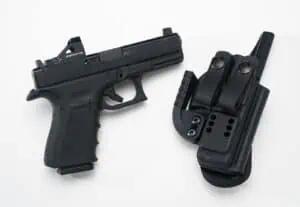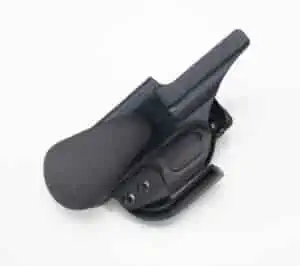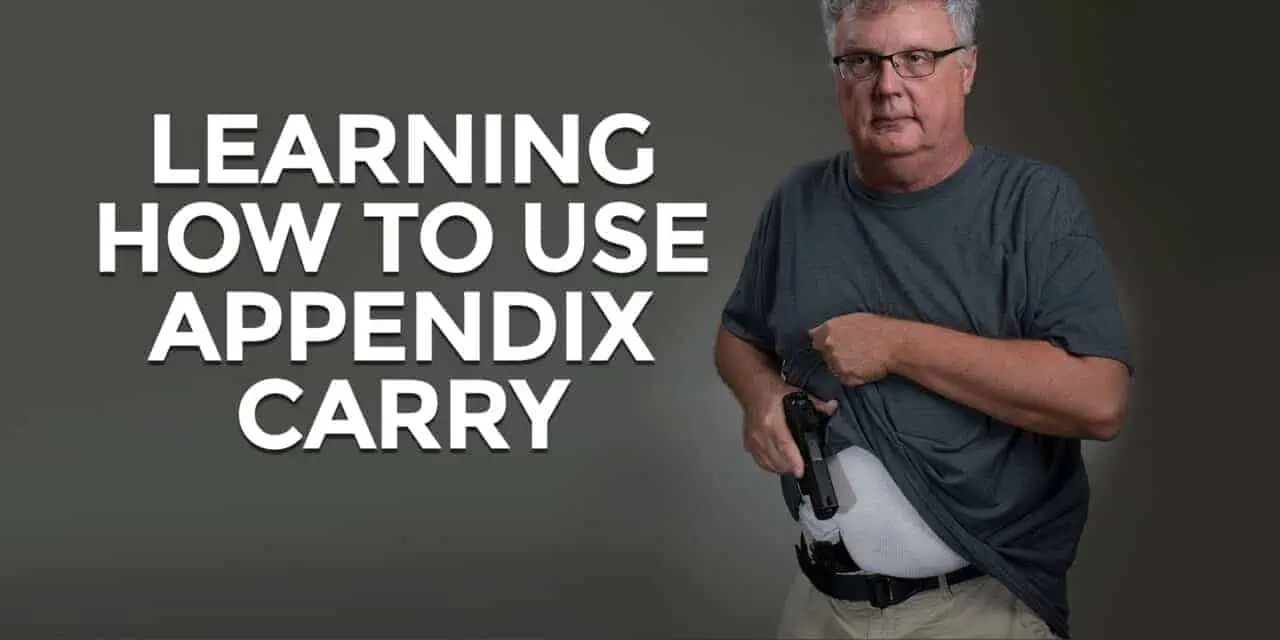Switching to AIWB Carry
I’m friends with a fair amount of high-level firearms trainers and gun writers. Over the years, it’s been interesting to see the changes in how they choose to carry a defensive firearm. When I first started out in the world of defensive firearms, strong side hip carry was the way to go. The majority of trainers taught to carry a defensive pistol on your hip, the same side as your dominant hand (right side if you’re right-handed, the opposite if you’re left-handed).
However, as I mentioned in a previous article, that started to change in the early 2000’s. Thanks to the efforts of noted firearms trainers like the late Todd Louis Green and others, carrying up front, by your appendix, inside the waistband, or AIWB, started to become increasingly popular.
I still carried on my right hip, though, mainly because I was competing in USPSA and IDPA at the time, and that’s the most common place for a holster in those sports. For added concealment, I carried inside the waistband (IWB) and I carried a smaller gun (a S&W Shield). For me, I felt that the time and effort needed to adjust my draw from what I was practicing to do better in matches should match what I was using for a defensive gun.
Yes, AIWB Is Safe
Surprisingly, the safety concerns of AIWB carry weren’t an issue for me. It’s true that your firearm is pointing at some important pieces of your anatomy when you carry AIWB. However, I already trusted the holster on my hip to keep my gun safe and secure when I carried, so trusting my holster when carrying AIWB was not that big of a jump for me.
Neither was worrying about safety on the draw or when resholtering, either. I bring my feet together and slide my hip out to one side when I reholster when carrying strong-side IWB. This puts my legs, feet and any other body parts out of the line of fire should something go horrendously wrong and I have a negligent discharge. The same is true when carrying AIWB. If you lean your hips forward when reholstering, it moves the important bits of your body out of the path of a bullet, increasing the safety of AIWB carry.
What finally convinced me to switch to AIWB carry was a conversation I had with my friend and firearms trainer Jeff Street. Jeff mentioned that his draw time was faster since he switched to AIWB, and that intrigued me greatly. My draw speed is rather slow. I have the reflexes of a three-toed sloth, and getting my time to first shot to be consistently under two seconds has been a chore.
Making The Switch to AIWB
 And so began my journey into carrying my pistol up front, inside the waistband. I decided to change not only my carry position but my carry gun as well. I went with a Glock 19 for a number of reasons. They have a wide range of holsters and hold more rounds than my Shield does, and I also wanted to switch to using a red dot sight as my primary optic. As there are almost an infinite array of red dot options for a Glock 19 versus the limited choices for a S&W Shield, it made sense to take the plunge and change everything all at once.
And so began my journey into carrying my pistol up front, inside the waistband. I decided to change not only my carry position but my carry gun as well. I went with a Glock 19 for a number of reasons. They have a wide range of holsters and hold more rounds than my Shield does, and I also wanted to switch to using a red dot sight as my primary optic. As there are almost an infinite array of red dot options for a Glock 19 versus the limited choices for a S&W Shield, it made sense to take the plunge and change everything all at once.
Myths about AIWB
First, let’s talk about some of the common misconceptions about AIWB carry. From what I’ve seen and read on the internet, the biggest problems with this carry method are:
- You can’t carry a gun with a hammer or a large backstrap because it will dig into your side with you carry at the appendix
- You can’t carry a full size gun AIWB
- You can’t sit down for a long time when carrying this way
All of these are true… if you are using a lousy holster. All of them go away, though, if you use a well-made holster that is optimized for carrying up front.
Let’s talk about the first issue, using a hammer-fired gun with an appendix holster. I have at least a dozen friends who carry tricked-out Beretta 92s in appendix holsters (some with bulky weapon lights attached to them). The Beretta is also a full-sized service pistol, so let’s declare those two myths busted and move on.
The last misconception about appendix holsters, that you can’t sit down while wearing one for an extended length of time, really depends on the quality of your holster and its set up. I initially chose a Dark Star Gear Orion holster for my Glock 19. However, I quickly noticed I was going to need to adapt the holster to my unique body type. The holster initially came with a metal clip to secure it to my belt. That clip was digging into my thigh on long road trips, though, so I changed it for a set of soft loops, and it’s much more comfortable now.
Gear For The Journey
 The teardrop-shaped piece of foam at the bottom of the holster is a Flat Muzzle Pad. This pad wedges into the gap between my thigh and torso and helps to press the gun into my body. This, in turn, makes the holster and gun more comfortable to wear for extended periods of time, especially when sitting down. I know it sounds a bit counterintuitive, but it works very well. I’ve been carrying this setup for weeks now, and I’ve had no problems wearing it while sitting down, even for hours at a time.
The teardrop-shaped piece of foam at the bottom of the holster is a Flat Muzzle Pad. This pad wedges into the gap between my thigh and torso and helps to press the gun into my body. This, in turn, makes the holster and gun more comfortable to wear for extended periods of time, especially when sitting down. I know it sounds a bit counterintuitive, but it works very well. I’ve been carrying this setup for weeks now, and I’ve had no problems wearing it while sitting down, even for hours at a time.
I was pleasantly surprised how easy it was to move from a strong-side hip to a front side AIWB holster. It took more time for me to find a good holster for my gun and adjust it to my body than it did when I carried on my right side. The payoff for this is, though, that I can carry a larger gun, and carry it completely discreetly.
The other payoff was my draw speed. With a little practice, I am now a full half-second faster on my draw with my new rig than I was carrying a Shield on my right hip. Some of that is due to using a red dot instead of a conventional front sight / rear sight setup, but in my testing, I’ve faster with the AIWB holster, no matter if I’m using a red dot or not.
Your Gear. Your Decisions
AIWB carry may not be right for you. There are legitimate safety concerns that need to be addressed, and some people just don’t find it comfortable, no matter how many holsters they try. However, if you’re looking to carry something a little bit bigger than your current carry gun, or want to speed up your draw time, you might want to give it a try, and see how it works for you.


